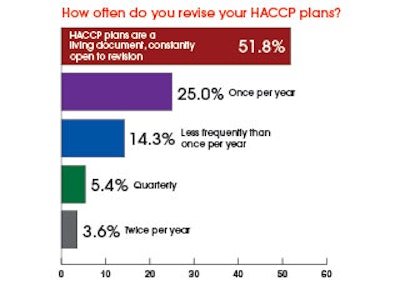
This article originally appeared in the January/February 2014 print issue of Food Manufacturing.
The Food Safety Update section of Food Manufacturing is designed to offer our readers insight into the state of food safety concerns across the industry. We received hundreds of responses to this month’s survey on juice processing.
The world juice market grew 6.4 percent in 2013 to hit $23 billion with support from health-conscious consumers, according to IBISWorld market research. Food Manufacturing polled our readers for a look into their juice-producing practices and opinions as requirements from both Hazard Analysis and Critical Control Points regulation and the Food Safety Modernization Act grow.
In the interest of food safety, 92.9 percent agreed with the FSMA mandate that all food manufacturing segments institute a HACCP plan. Juice producers frequently alter HACCP plans, with 51.8 percent of respondents agreeing that “HACCP plans are a living document, constantly open to revision.” Five percent revise them quarterly, and 3.6 percent said twice a year. One-quarter of respondents said they revise their HACCP plans annually. Approximately 14 percent said they revise them less frequently than that.
Nearly half (46.4 percent) of juice-producing respondents said they produce a combination of juice and non-juice products, while 21.4 percent produce only juice. Most respondents said they used the same HACCP plan for all of the products they produce.
Nearly 86 percent of respondents said the FDA’s guidance for HACCP in juice facilities is appropriate to address the specific challenges and critical control points associated with juice processing. However, one respondent suggested the FDA guidance needed more stringent definition, while another said that increasing amounts of foreign juice ingredients were a major issue. The FSMA proposed rule on Foreign Supplier Verification Programs in regards to juice imports exempts juice from foreign facilities that are in compliance with the HACCP regulations, which contain their own supplier verification provisions.
Effective HACCP planning incorporates many integral factors. The publicly available HACCP guidance published by the FDA was deemed effective by 66 percent of respondents. Nearly 65 percent said internal QA/QC experts were influential in HACCP planning. Almost half used suggestions from plant floor staff.
Approximately 62 percent of respondents said new FDA rules regarding washing of produce at the farm level would not impact their business. Since the survey was taken, the FDA announced it would revise a swathe of FSMA rules regarding production at farm level. Nonetheless, nearly 38 percent expected the original produce-washing rules to change their business. Several respondents noted that washing the fruit would reduce pesticide residue, add controls or reduce contamination levels. Some respondents were concerned about the possibility of higher priced product due to the extra rule. One respondent mentioned that the need to wash fruits could hasten processing since wet fruits are prone to mold.
Food Manufacturing readers are following trends in high-pressure processing, better known as HPP. Market research firm Visiongain estimated that the global food HPP market reached $7.34 billion in 2013. Nearly 30 percent of survey respondents said they use HPP in their juice operations. Of those that did not, 36.5 percent said they planned to adopt HPP technology in the next year.























